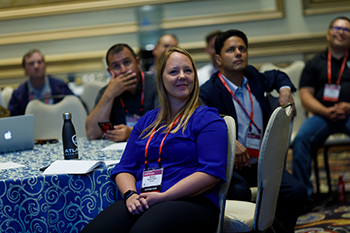.png?sfvrsn=b524e1f4_0) The Emerging Technology Community met on Monday at ChannelCon for a working session in which they debated and ultimately determined opportunities as well as challenges when implementing and monetizing emerging technologies within their businesses. Here are some of the top takeaways from the meeting.
The Emerging Technology Community met on Monday at ChannelCon for a working session in which they debated and ultimately determined opportunities as well as challenges when implementing and monetizing emerging technologies within their businesses. Here are some of the top takeaways from the meeting.
Incorporate emerging technologies into existing products.
Community members agreed that the simplest way to add emerging technologies to their businesses is to incorporate them into existing products—versus creating a new product to sell. The key, according to members, is showing value to the customer particularly when there is an added cost associated with the technology.
“How do I incorporate emerging technologies into my present business to increase efficiencies and add value for my customers? They have to be willing to pay for it,” said one member.
Seek out partners who are experts in emerging tech.
Small businesses don’t always have the resources to research and develop new technologies, but partnerships can fill the gap. One member shared her experience working with a partner company focused on data and AI. “We’re good at collecting a lot of data, but have no way of producing results and giving our customers information on all that data. We don’t specialize in data mining and AI, so we’re partnering with a company to do that work for us.”
Other members agreed. “When you partner with experts, you have higher levels of success,” said Dave Sobel, senior director of MSP evangelism, SolarWinds MSP.
Address the talent gap.
Members noted that not only is there a massive talent gap, workers are also being replaced by technology. But when it comes to emerging technologies, how do you hire for the right skills when you don’t know exactly what the right skills are?
“Sometimes the problem you’re solving, there isn’t a solution,” said Jim Hamilton, vice president of member communities. “You have to train people to solve the problem and become the experts.”
In order to staff your business to be ready for emerging technologies, one solution is to invest in creating your own workforce.
Encourage innovation with a dedicated position.
When working within a company that sells, distributes or influences the adoption of technology, innovation is paramount to survival. But members identified that often, no one assumes responsibility for innovation.
“Who in the business is responsible for growing the business and staying extremely competitive? That role is missing,” said Paul Cronin, CEO, Apogee IT Services.
Cristina Greysman, partner strategy, Amazon Web Services, suggested that the Emerging Technology Community lead the charge on defining the role of innovation officer.
“The challenge is that partners don’t have someone thinking about next-gen technologies, and how to embrace them and monetize them,” said Greysman.
Prioritize finding and creating use cases.
When determining whether or not an emerging technology is right for your business, use cases are often the first place technology professionals can look for inspiration. That’s why the community has prioritized including use cases in its forthcoming series of three white paper on business opportunities in IoT, AI and 5G.
"These use cases are fodder for thought. I encourage you to think about your core business and what your customers value from you and how you can take the next step. Then, document and make it repeatable and create your own use cases,” said Mike Haines, director of worldwide partner incentive strategy, Microsoft, and chair of the Emerging Technology Community.
Develop a marketing strategy and program.
Shari Marion, managing director, Publicis Hawkeye, presented on developing marketing strategies and programs around emerging technology opportunities. Marion pointed out that with emerging technologies, there are often unknowns. She shared five tips for marketing emerging technologies including knowing your audience, your product and service, what makes you different, and your message and how to deliver it. The goal, according to Marion, is to understand the customer journey and create content that supports each step of the buying process.
“What does your product do for your audience? It’s more than technical specifications. How does your solution solve a problem?” said Marion.
Want more ChannelCon 2019? Check out more coverage of daily highlights, educational tracks and general sessions.



 Add CompTIA to your favorite RSS reader
Add CompTIA to your favorite RSS reader
